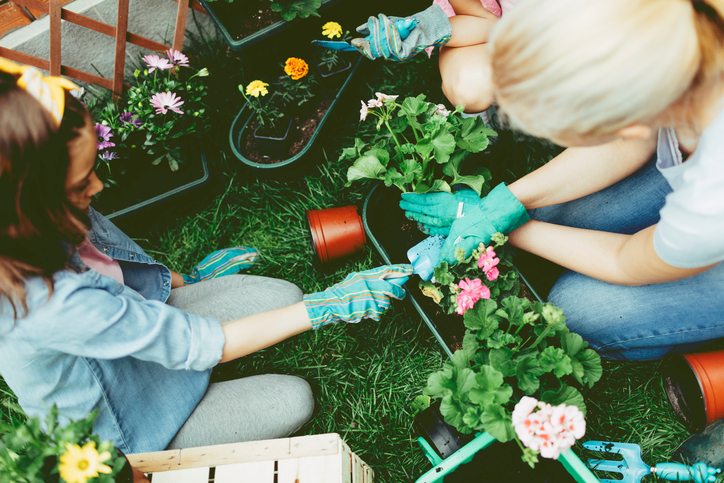Hidden behind a community house in suburban Melbourne is a maze of raised garden beds. In the middle, there’s a community herb plot with a sign inviting people to responsibly pick their share. A bathtub sits in the top corner overflowing with brilliant orange nasturtium alongside the burgundy lobed leaves of oakleaf lettuces.
This community garden is just one of many dotted throughout cities and towns tended by local green and black thumbs. They’re privy to a secret that long-time gardeners have always known – gardening is good for you. What’s more, the anecdotal experience is now backed up by science.
While gardens and greenspace have long been considered integral to humans’ wellbeing, the practice of “horticultural therapy” and “therapeutic horticulture” – using gardening and plants to improve mental health and wellbeing – is still relatively new.
Research into gardening programmes has shown positive outcomes across a diverse range of groups, including people with depression and dementia, and the socially isolated. If, as the World Health Organization predicts, depression becomes the second-leading cause of disability globally by 2020, gardening could offer a quality community-based care option with individual, social and environmental benefits. For now, the deceptively simple concept behind therapeutic gardening is still looking to go mainstream.
“A lot of people think ‘what’s a bit of gardening going to do?’” says Toni Salter, President of Cultivate NSW. “When there’s evidence-based practice, evidence-based research with quantifiable results, then people can start to listen and take notice of the effects of gardening.”
Such evidence has been building since the 1980s before a series of qualitative studies in the 2000s grabbed wider attention. Broadly, study participants showed improved mood and a sense of inner peace or calm. They felt more connected, safer and more secure in a neutral environment.
Research into community gardening added increased alertness, improved social interaction and community cohesion, and a reduction in stress and associated depression to the list of benefits. The participants also saw an alleviation in symptoms of dementia and Alzheimer’s disease.
A number of studies have specifically investigated the impact of horticultural therapy on participants with depression. One such study, published in 2011, found positive and sustained effects in participants though existential issues remained. The participants themselves reported finding the experience meaningful, interesting and instructive.
If prevention is better than cure, then gardening may be the answer here too. A 1995 French study of more than 2000 older people found that regular gardening may help to prevent dementia. Studies in 2005 and 2006 made similar findings in relation to Alzheimer’s disease.
GARDENING INTUITION
In Australia, local research and awareness of the practice remains sparse. The terminology varies and there isn’t a nationally recognised training pathway for practitioners, though work is being done to change this. It seems many people still come to horticultural therapy via an innate understanding that gardening makes them feel good.
For Salter, it was her lived experience that first brought the benefits to her attention. In the late 1990s, Salter was on maternity leave from her corporate sales role when she found herself drawn to the garden. “It was what I enjoyed doing. And when I had the kids, it became my therapy,” she says. “I can look back now and identify signs of post-natal depression. I didn’t realise at the time, but I was struggling emotionally.”
Pottering in the garden became her way to emotionally recharge. It gave her a sense of joy and satisfaction to tend to the plants and harvest her own vegies. It wasn’t until 2008 when Salter, now running workshops as The Veggie Lady, was approached to set up a gardening programme at a disability centre. This became her first formal encounter with horticultural therapy. The program was a great success and Salter was converted. Nearly a decade later, she now runs “gardening as therapy” workshops for a range of people, from community development workers to nurses, to promote the benefits of gardening.
A VERSATILE REMEDY
One reason therapeutic gardening promises so much is its versatility; participation can be active or passive and adapted to all environments, ages and abilities.
This aspect caught the attention of Renée Gardiner, founder and CEO of Growing Change, an organisation that promotes mental health and wellbeing through social horticulture.
After Gardiner lost her mum to suicide, she felt driven to find a way to support others in similar circumstances. She’d seen how socially isolated her mum had become and she’d also seen how gardening had helped to alleviate that isolation.
“The one thing she seemed to enjoy the most – and the one thing that would pull her outside of the house – was pottering in her small garden,” Gardiner recalls. “And I thought, there’s an opportunity for people to come together in this way, outside of their homes, and to use gardens as a means of connection and employment.”
She began researching and stumbled across horticultural therapy. It was a light-bulb moment. “What I saw in my mum is actually something that is evidenced internationally,” she says. “And … anyone can be involved in gardening, whatever their abilities.”
The model Gardiner eventually settled on was social farming. She set up a market garden on 1500 square metres that operates as a social enterprise, supplying local restaurants with organic produce.
Working with local referral partners, Growing Change invites participants in vulnerable circumstances to join them for a 12-week period. But Gardiner is quick to point out she is not a mental health worker: “We’re farmers first and foremost, not therapists. That’s how our model works and that’s why it works, because when people come together here, they’re not coming to do therapy because they’re sick, they’re coming to farm.”
RECOVERY EFFORT
In Christchurch, an organisation called Greening the Rubble shows how gardens and gardening can positively impact disaster recovery. Greening the Rubble was a response to the earthquakes that devastated Christchurch in 2010 and 2011. Looking for a way to draw people back the city, the group turned to plants.
In the early days, it was about creating greenspace amid the destruction and, as Greening the Rubble coordinator Laura Sessions explains, it offered a meaningful activity for the volunteers involved. “Everyone was dealing with the aftermath of the earthquakes in their own way, and I think it was a way for people who were involved with the project to do some healing themselves,” Sessions says.
Initial projects in the CBD incorporated biophilic principles, based on Edward O. Wilson’s theory that humans innately seek connectedness to nature. Six years on, Greening the Rubble has changed its focus from the city to the suburbs, concentrating on communities where public spaces were lost to the earthquake.
“We’re trying to use the principles to create spaces that will improve people’s lives in lots of different ways. From their physical health to things like alleviating social isolation [and] creating spaces to meet and sources of community cohesion,” Sessions says.
It’s this opportunity to connect in a meaningful way to nature that seems to be at the heart of therapeutic gardening. If you needed a reason to step into a garden, then this is it. It just might do you good.







